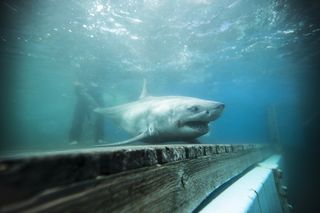Did a Great White Shark Really Enter Long Island Sound?

A great white shark thought to have entered Long Island Sound — a possible first for a great white shark in that body of water — may not have been there at all.
Cabot, a 9-foot-8-inch-long (nearly 3 meters) male shark, seemed to pop up off the coast of Greenwich, Connecticut, Monday morning (May 20). When a tagged shark's dorsal fin breaches the water's surface, nearby satellites "ping" the location to whomever is tracking the fish. In the case of Cabot, the nonprofit Ocearch got the ping, suggesting the shark was in Long Island Sound.
The problem with these trackers is that they don't give an exact location. "There's a huge error bar to the right or left of whatever location they give you," said George Burgess, a marine biologist and director emeritus of the Florida Program for Shark Research at the Florida Museum of Natural History. "And that error bar can be the difference between one side of Long Island and the other."
Sure enough, less than a day later, Cabot's tracker pinged well off the southern shore of Long Island, outside of the sound, Ocearch posted on its Facebook page. That would mean Cabot had traveled nearly 200 miles (320 kilometers) in just half a day, The New York Times reported.
"He either was in the sound or he was never in the sound," said Ocearch spokesperson John Kanaly, as reported by The Times. "We have calculated that he wouldn't have had time to go all the way around the island and back." [In Photos: Great White Shark Washes Up on Santa Cruz Beach]
Long Island Sound is a tidal estuary connected to the Atlantic Ocean and located between Connecticut (to the north) and Long Island (to the south). Burgess, a shark scientist, said he doesn't recall any record of a great white shark in that body of water. And possibly for good reason — the shark's primary prey, seals, haven't been seen in the sound in any abundance since before the 1960s, Burgess said.
"I suspect as the seals disappeared from Long Island Sound, so did their predator, the great white shark," he added.
Sign up for the Live Science daily newsletter now
Get the world’s most fascinating discoveries delivered straight to your inbox.
Other large sharks, most of which prefer warm water (unlike the cold-water-loving great white), make their way up to Long Island via the Gulf Stream. This "river" of warm water in the sea travels from the Gulf of Mexico into the Atlantic Ocean at the southern tip of Florida and then up the East Coast all the way north to Newfoundland. But that warm current doesn't flow into the Long Island Sound.
Even so, the great white shark is a migratory animal, traveling as far south as Florida and the Gulf of Mexico and as far north as Newfoundland. So, perhaps Cabot was making his way up toward New England for the summer, but instead of taking a slight right turn at New York, the shark turned left, essentially making a "wrong turn," Burgess speculated.
If the subadult shark Cabot did indeed enter Long Island Sound, there's no need to worry as beachgoers head to the sun and sand for Memorial Day weekend.
"It's an interesting record and a great piece of information to know that Long Island Sound is still going to be a good enough place for a white shark to wander into," Burgess told Live Science. But as far as a danger to humans, that's an afterthought."
Earlier this month, on May 9, Ocearch got a ping from a 15-foot (4.6 m) great white shark dubbed Luna over the deepwater feature known as the Charleston Bump, off the coast of South Carolina. Another shark, 12-foot-9-inch-long (3.9 m) Caroline pinged that same day from closer to shore at South Carolina's Edisto Beach.
- Marine Marvels: Spectacular Photos of Sea Creatures
- The 10 Weirdest Sea Monsters
- 15 of the Largest Animals of Their Kind on Earth
Editor's Note: This article was updated with new information on the location of Cabot, information suggesting the shark may not have entered Long Island Sound at all.
Originally published on Live Science.

Jeanna served as editor-in-chief of Live Science. Previously, she was an assistant editor at Scholastic's Science World magazine. Jeanna has an English degree from Salisbury University, a master's degree in biogeochemistry and environmental sciences from the University of Maryland, and a graduate science journalism degree from New York University. She has worked as a biologist in Florida, where she monitored wetlands and did field surveys for endangered species. She also received an ocean sciences journalism fellowship from Woods Hole Oceanographic Institution.
